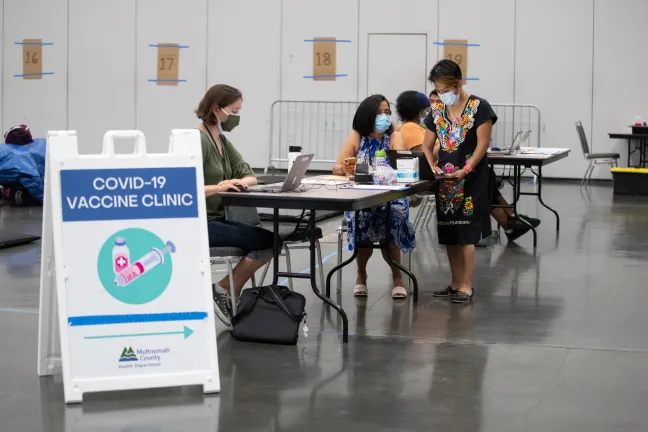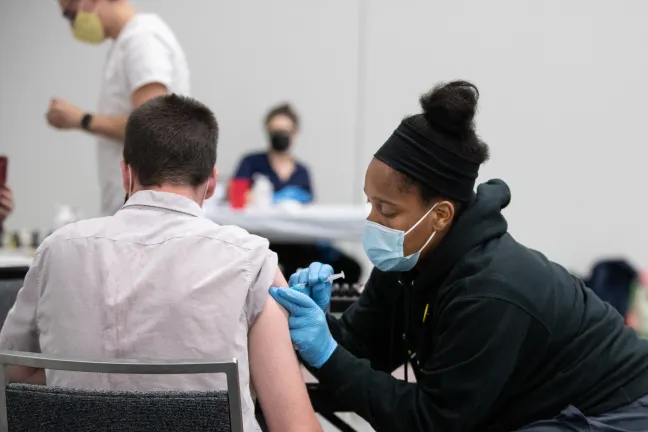With more than 360,000 Multnomah County residents still not fully vaccinated, Public Health urges continued precautions.
Gov. Kate Brown today lifted statewide restrictions that have slowed the spread of COVID-19, allowing businesses to welcome more people, and allowing guests to enter bars, restaurants, gyms and bowling alleys without wearing their masks.
In an order signed last week, the governor rescinded nearly all COVID-19 restrictions issued under emergency statutes. Those restrictions included requiring a mask in most public spaces, and placing capacity limits and physical distancing requirements on businesses and public spaces. Mask requirements remain in some settings under state and federal rules, including in airports and public transit, adult and youth detention, healthcare settings, and shelters and transitional housing.
“This is an important day for Multnomah County,” said Chair Deborah Kafoury. “It’s a day to remember the 615 people our county lost to COVID-19 and to grieve with their families. It’s a day to thank our healthcare, grocery and other essential workers who kept us all going. And it’s a day to celebrate the people who have continued to work, teach, pray and connect us, whether online or in masks.”
Oregon’s COVID-19 restrictions — and our community’s compliance with them — saved lives, she said. Multnomah County battled back from a steep surge last fall, sending case rates down until COVID-19 vaccines became available. More than 72 percent of those eligible have been vaccinated.
Yet, even as vaccinations continue to slow the overall spread of COVID-19, health officials caution that COVID-19 will continue to pose a risk to people who have not yet been fully vaccinated or cannot get vaccinated as the virus morphs into more contagious and thus more deadly forms. More than 364,00 people in Multnomah County are not fully vaccinated and fewer than 50,000 of those have received the first shot.
“We all have this desire to move on, but COVID is not going away,” said Public Health Director Jessica Guernsey. “There are so many people who are still at risk, and newer, more serious versions of the virus are on the horizon. As a community we still have work to do, to protect our friends, our family, our coworkers, and the people who take care of us as frontline workers.”
Multnomah County Public Health recommends that anyone who has not yet received a full series of the COVID-19 vaccine do so as soon as possible.
Public Health also recommends that anyone who is not fully vaccinated (two weeks following the full series of vaccines) should continue to wear a mask whenever they are indoors around other people who are not fully vaccinated or whose vaccination status is unknown. Anyone who is immunocompromised should get specific advice from their health care provider.
“COVID hospitalizations and deaths are now almost completely avoidable through vaccines that are safe and effective. Thank you to everyone who has been vaccinated and followed precautions to tame this virus. I strongly encourage everyone who is eligible to get vaccinated," said Dr. Jennifer Vines, Multnomah County’s health officer.
[Find upcoming county vaccine clinics here]
Multnomah County employees will continue masking
Even after the Governor lifts statewide restrictions, Multnomah County health officials recommend businesses and individuals take precautions to keep the community safe.
Multnomah County will continue to require masks for all County employees in County buildings and will request that anyone visiting a County building also wear a mask. The County will revisit this guidance later this summer.
More than half the County workforce has reported for in-person work since the pandemic began. Others transitioned quickly to teleworking in March 2020. In an email to employees June 29, Chair Kafoury said onsite services will be staged to return throughout the summer based on community need. County departments are evaluating options for ongoing telework for some employees and positions. By early September, all County offices are expected to reopen for onsite service.
A long road to reopening
The road to reopening businesses and resuming social lives has been long — and challenging.
A month after the state saw its first case of COVID-19, Gov. Brown banned large gatherings, then closed schools — temporarily at first — and limited restaurants to take-out and delivery. Then on March 22, County officials called for a statewide stay-home order. The next day, Brown issued her “Stay home, Save Lives” order.
In early May 2020, the state outlined its first “Reopening” plan. The three-phased plan required counties to meet several prerequisites, and additional requirements as part of a region. With a surveillance system hobbled by lack of testing and case counts creeping up, Multnomah County moved cautiously ahead. It entered the first phase of reopening in mid-June 2020.
On July 1, 2020, Brown announced a statewide mask mandate. The rule extended a regional face covering mandate that included Multnomah County. Later that month the state announced it had added Multnomah County to a list of Oregon counties with high rates of sporadic disease: cases of the virus that cannot be traced to a source.
In September 2020, cases started rising across the state, and by October, Multnomah County had landed back on the Watch List, alongside a growing list of counties. To slow the rapid spread ahead of the Thanksgiving holiday, Brown in November announced a two-week statewide “Freeze.”
The State on Nov. 25 announced a new “Risk and Protection” reopening framework based on a county’s level of COVID-19 spread — Extreme Risk, High Risk, Moderate Risk and Lower Risk. Risk was assessed based on two criteria: the rate of disease in the county and the percent of people testing positive for the virus.
When the “Freeze” lifted Dec. 3, 2020, Multnomah County entered the new framework under “Extreme Risk.”
Then last month, in May 2021 — with vaccination rates rising and vaccine supplies increasing — Brown announced new reopening metrics, this time based on vaccination rates. It was a dramatic shift in the state’s direction on COVID-19, moving away from a reopening plan based on the level of COVID-19 spread and toward a target of vaccinating 70 percent of the eligible population.
Because the State’s vaccine rollout prioritized job functions and access to healthcare, disparities have persisted, especially in communities with higher barriers to vaccines because of geography, language and lack of access to health care, and higher risks of COVID-19 infections due to frontline jobs, multigenerational households and historic racism.
“Our community is going to have to work for every vaccine going forward and we need to understand exactly what barriers people are facing to getting their shot,” Vines said at the time. “But we’re also hopeful because this rapid course change shows the power of the vaccines and just how quickly we can protect one another if we do this right.”


